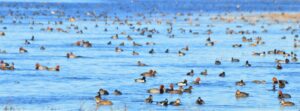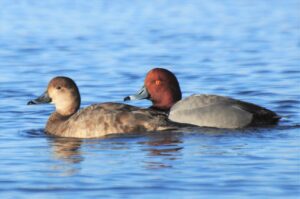Photography courtesy of Lowell Washburn, all rights reserved.
The white-hot stars of a spring night were rapidly fading into nothingness. Meanwhile, the eastern horizon was being set ablaze by strengthening hues of the impending sunrise. A new day was beginning at the Ventura Marsh.
The transition was greeted by a symphony of familiar wetland sounds – the soft splashing of waves, the brittle rustle of winter dried cattails, the trill of red-wings, and the overlapping voices of a thousand meowing cats. That’s right, the sound of meowing cats; smack in the middle of a 200-acre marshland.
Although the sounds were indeed cat-like, the daybreak symphony was emanating from the most unlikely of sources — a massive, mile-long gathering of redhead ducks. Sequestered within the dark confines of my photo blind, I was hoping for some closeup viewing of one of North America’s most beautifully unique waterfowl.

Redheads are members of the diving duck clan. And like all divers, they earn their living by diving to the bottom of lakes and marshes where they glean the nutrient rich seeds and roots of aquatic plant life. After spending the winter on the coastal marshes and lakes of Texas and northern Mexico, redhead flocks are currently enroute to traditional nesting grounds, mainly in prairie Canada. In Iowa, wetlands like the Ventura Marsh provide critical rest and refueling stations as birds continue their rigorous northward journey.
Spring courtship begins on the wintering grounds and continues as flocks move up the flyway. Females may simultaneously attract multiple suitors with each drake doing its level best to outcompete rivals. The male’s unique display begins with a preliminary ‘throat puff’ as the drake raises and bends his neck, before loudly emitting the distinctive slurring “meow”. The cat call display often concludes with the drake vigorously snapping back his head until the crown touches his lower back.
If the displays become too overwhelmingly, the hen may partially submerge and try to ditch her suitors by rapidly swimming away. When this fails, the hen may try to escape by diving – a maneuver which is, of course, immediately imitated by the courting males. Once the beleaguered hen resurfaces, she may decide to take wing. The drakes immediately follow suit as the spring ritual quickly becomes a high-speed aerial ballet as the flock twists and turns through the morning sky.
By the time the birds arrive on the marshes of Manitoba, the female will have chosen her mate and spring nesting begins.




 Susan Judkins Josten
Susan Judkins Josten Rudi Roeslein
Rudi Roeslein Elyssa McFarland
Elyssa McFarland Mark Langgin
Mark Langgin Adam Janke
Adam Janke Joe Henry
Joe Henry Sue Wilkinson
Sue Wilkinson Tom Cope
Tom Cope Kristin Ashenbrenner
Kristin Ashenbrenner Joe Wilkinson
Joe Wilkinson Dr. Tammy Mildenstein
Dr. Tammy Mildenstein Sean McMahon
Sean McMahon